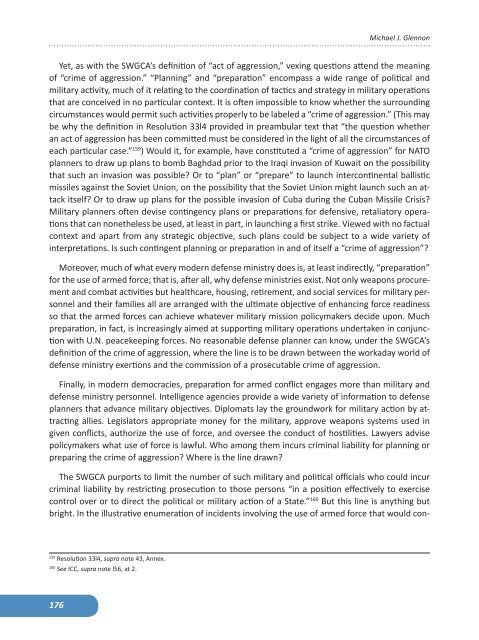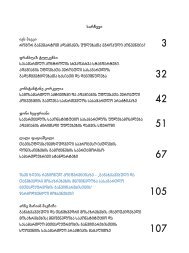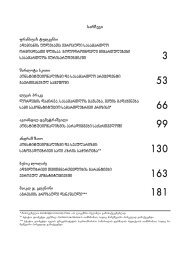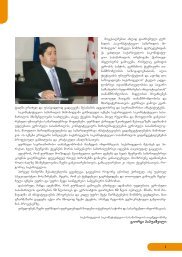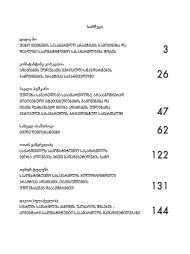Contents - Constitutional Court of Georgia
Contents - Constitutional Court of Georgia
Contents - Constitutional Court of Georgia
Create successful ePaper yourself
Turn your PDF publications into a flip-book with our unique Google optimized e-Paper software.
176<br />
Michael J. Glennon<br />
Yet, as with the SWGCA’s definition <strong>of</strong> “act <strong>of</strong> aggression,” vexing questions attend the meaning<br />
<strong>of</strong> “crime <strong>of</strong> aggression.” “Planning” and “preparation” encompass a wide range <strong>of</strong> political and<br />
military activity, much <strong>of</strong> it relating to the coordination <strong>of</strong> tactics and strategy in military operations<br />
that are conceived in no particular context. It is <strong>of</strong>ten impossible to know whether the surrounding<br />
circumstances would permit such activities properly to be labeled a “crime <strong>of</strong> aggression.” (This may<br />
be why the definition in Resolution 33l4 provided in preambular text that “the question whether<br />
an act <strong>of</strong> aggression has been committed must be considered in the light <strong>of</strong> all the circumstances <strong>of</strong><br />
each particular case.” 159 ) Would it, for example, have constituted a “crime <strong>of</strong> aggression” for NATO<br />
planners to draw up plans to bomb Baghdad prior to the Iraqi invasion <strong>of</strong> Kuwait on the possibility<br />
that such an invasion was possible? Or to “plan” or “prepare” to launch intercontinental ballistic<br />
missiles against the Soviet Union, on the possibility that the Soviet Union might launch such an attack<br />
itself? Or to draw up plans for the possible invasion <strong>of</strong> Cuba during the Cuban Missile Crisis?<br />
Military planners <strong>of</strong>ten devise contingency plans or preparations for defensive, retaliatory operations<br />
that can nonetheless be used, at least in part, in launching a first strike. Viewed with no factual<br />
context and apart from any strategic objective, such plans could be subject to a wide variety <strong>of</strong><br />
interpretations. Is such contingent planning or preparation in and <strong>of</strong> itself a “crime <strong>of</strong> aggression”?<br />
Moreover, much <strong>of</strong> what every modern defense ministry does is, at least indirectly, “preparation”<br />
for the use <strong>of</strong> armed force; that is, after all, why defense ministries exist. Not only weapons procurement<br />
and combat activities but healthcare, housing, retirement, and social services for military personnel<br />
and their families all are arranged with the ultimate objective <strong>of</strong> enhancing force readiness<br />
so that the armed forces can achieve whatever military mission policymakers decide upon. Much<br />
preparation, in fact, is increasingly aimed at supporting military operations undertaken in conjunction<br />
with U.N. peacekeeping forces. No reasonable defense planner can know, under the SWGCA’s<br />
definition <strong>of</strong> the crime <strong>of</strong> aggression, where the line is to be drawn between the workaday world <strong>of</strong><br />
defense ministry exertions and the commission <strong>of</strong> a prosecutable crime <strong>of</strong> aggression.<br />
Finally, in modern democracies, preparation for armed conflict engages more than military and<br />
defense ministry personnel. Intelligence agencies provide a wide variety <strong>of</strong> information to defense<br />
planners that advance military objectives. Diplomats lay the groundwork for military action by attracting<br />
allies. Legislators appropriate money for the military, approve weapons systems used in<br />
given conflicts, authorize the use <strong>of</strong> force, and oversee the conduct <strong>of</strong> hostilities. Lawyers advise<br />
policymakers what use <strong>of</strong> force is lawful. Who among them incurs criminal liability for planning or<br />
preparing the crime <strong>of</strong> aggression? Where is the line drawn?<br />
The SWGCA purports to limit the number <strong>of</strong> such military and political <strong>of</strong>ficials who could incur<br />
criminal liability by restricting prosecution to those persons “in a position effectively to exercise<br />
control over or to direct the political or military action <strong>of</strong> a State.” 160 But this line is anything but<br />
bright. In the illustrative enumeration <strong>of</strong> incidents involving the use <strong>of</strong> armed force that would con-<br />
159 Resolution 33l4, supra note 43, Annex.<br />
160 See ICC, supra note l56, at 2.


